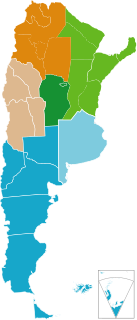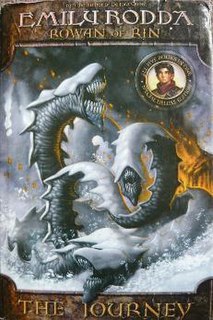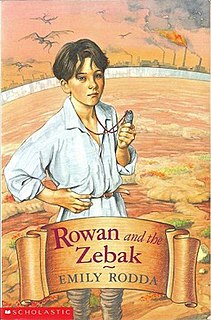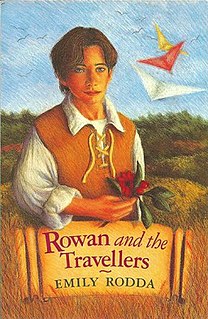
Rowan of the Bukshah (titled Rowan and the Ice Creepers in North America) is a 2003 children's fantasy novel by Australian author Emily Rodda. [1] It is the fifth and final book in the Rowan of Rin series.

Rowan of the Bukshah (titled Rowan and the Ice Creepers in North America) is a 2003 children's fantasy novel by Australian author Emily Rodda. [1] It is the fifth and final book in the Rowan of Rin series.
Winters have been getting colder and longer the past few years, posing mounting problems for the people of the valley of Rin. This year, in what should be spring the people are still in the dead of winter, with no end to the cold in sight. The people are worried, because if the winter continues much longer, their food storehouses will be empty. A decision is made to evacuate to the coast, to finish the winter with the Travelers and the Maris. The group departs, leaving behind Rowan, Brondon, Sharron and Norris. Rowan will care for his beloved Bukshah; Brondon will care for Lann, the elderly village leader; and the other two are newcomers to the group who returned with Rowan from the Land of the Zebak. When a new enemy, the ice creepers, are discovered, Rowan follows Sheba's advice. He takes Norris and Sharron, and sets off on a long trek through the land following the Bukshah. Along the way, Zeel joins the trek (thus completing the introductory rhyme; Sharron to weep, Norris to fight, Rowan to dream, and Zeel for flight). The Bukshah lead them to the mountain, where they learn some new and terrifying facts.
When the Bukshah are fenced, they cannot go up the mountain to eat the seals on the ice creeper nests, preventing the numbers from growing and the habitual spreading. When the ice creepers multiply they cause the cold to grow. When the Bukshah are free to roam, they make an annual pilgrimage to the mountain and keep the ice creepers under control, preventing the rise of a cold time.
Far more chilling is the extended truth about what happened to the people of the Valley of the Gold. In Travelers , Rowan already discovered the truth about the destruction of the Valley of Gold. Due to the mountain berry plants the soil was loosened and the Valley was destroyed by a landslide. Here he learns much more.
When the Zebak invaded and word of the invasion was sent to the Valley, the message was received. Leaving only two behind (the Keepers of the Bukshah and the Silks), the villagers set out for the coast. On their way they were ambushed by the Zebak, captured and taken as slaves. One man escaped and returned to the Valley to warn the others. Fearing other attacks the three followed the Bukshah into the heart of the mountain where they were trapped by the landslide that destroyed the Valley as they knew it. Rowan and his companions learn this from the silks that were kept as up-to-date as possible. From this they learn the truth, that the people of Rin were once the people of the Valley of the Gold, that the land is their home, and has always been their home.

The Himalayas, or Himalaya, is a mountain range in Asia, separating the plains of the Indian subcontinent from the Tibetan Plateau. The range has some of the planet's highest peaks, including the very highest, Mount Everest. Over 100 peaks exceeding 7,200 m (23,600 ft) in elevation lie in the Himalayas. By contrast, the highest peak outside Asia is 6,961 m (22,838 ft) tall.

Norway is a country located in Northern Europe in the northern and western parts of the Scandinavian Peninsula. The majority of the country borders water, including the Skagerrak inlet to the south, the North Sea to the southwest, the North Atlantic Ocean to the west, and the Barents Sea to the north. It has a land border with Sweden to the east and a shorter border with Finland and an even shorter border with Russia to the northeast.

Saltdal is a municipality in Nordland county, Norway. It is part of the traditional district of Salten. The administrative centre of the municipality is the village of Rognan. Other villages in Saltdal include Røkland and Lønsdal.

Philmont Scout Ranch is a ranch located in Colfax County, New Mexico, near the village of Cimarron; it covers 140,177 acres (56,728 ha) of wilderness in the Sangre de Cristo Mountains on the east side of the Cimarron Range of the Rocky Mountains. Donated by oil baron Waite Phillips, the ranch is owned and operated by the Boy Scouts of America. It is a National High Adventure Base where crews of Scouts and Venturers take part in backpacking treks and other outdoor activities. By land area, it is one of the largest youth camps in the world. During the season, between June 8 and August 22, an estimated 22,000 Scouts and adult leaders backpack through the Ranch's extensive backcountry. More than 1,130 seasonal staff are responsible for the Ranch's summer operations.

Denali National Park and Preserve, formerly known as Mount McKinley National Park, is an American national park and preserve located in Interior Alaska, centered on Denali, the highest mountain in North America. The park and contiguous preserve encompass 6,045,153 acres which is larger than the state of New Hampshire. On December 2, 1980, 2,146,580-acre Denali Wilderness was established within the park. Denali's landscape is a mix of forest at the lowest elevations, including deciduous taiga, with tundra at middle elevations, and glaciers, snow, and bare rock at the highest elevations. The longest glacier is the Kahiltna Glacier. Wintertime activities include dog sledding, cross-country skiing, and snowmobiling. The park received 594,660 recreational visitors in 2018.

Argentina has a vast territory and a variety of climates and microclimates ranging from tundra and polar in the south to the tropical climate in the north, through a vast expanse of temperate climate. Natural wonders include the Aconcagua, the highest mountain in the world outside the Himalayas, the widest river and estuary of the planet, the Iguazú Falls, the Humid Pampas, and the Argentine Sea. Visitors enjoy the culture, customs and Argentine cuisine.

Snowbird is an unincorporated community in Little Cottonwood Canyon in the Wasatch Range of the Rocky Mountains near Salt Lake City, Utah, United States. It is most famous for Snowbird Ski and Summer Resort, an alpine skiing and snowboarding area, which opened in December 1971.

Gorak Shep or Gorakshep is a small settlement that sits on the edge of a frozen lakebed covered with sand in Nepal with the same name. It is found at an elevation of 5,164 metres (16,942 ft) elevation, near Mount Everest. The village is not inhabited year-round.

Rowan of Rin is a series of five children's fantasy novels by an Australian author Emily Rodda. It follows the adventures of a shy village boy, Rowan. The series was first published in Australia in 1993 by Omnibus Books, a corporate division of Scholastic. When Scholastic released Emily Rodda's Star of Deltora fantasy series, the Rowan of Rin series was revealed to be part of the world of Deltora, and the lands mentioned in the books are islands located to the west of Deltora. This makes Rowan of Rin the fourth series set in the world of Deltora, sixth if you count the collective Deltora Quest series as three separate series. The other series are Deltora Quest, the Three Doors trilogy and Star of Deltora.
Khardung La or Khardung Pass is a mountain pass in the Leh district of the Indian union territory of Ladakh.

Rowan of Rin is a children's fantasy novel by Australian author Emily Rodda. It is the first in the five-book series of the same name. It was first published in 1993 and re-released in 2003 with the fifth and final novel in the series: Rowan of the Bukshah.In 1994, the novel won the Children's Book of the Year Award for Younger Readers.

Rowan and the Keeper of the Crystal is a 1996 children's fantasy novel by Australian author Emily Rodda. It is the third book in the Rowan of Rin series.

Rowan and the Zebak is a 1999 children's fantasy novel by Australian author Emily Rodda. It is the fourth book in the Rowan of Rin series.

Hemis National Park is a high-altitude national park in Ladakh, India. Globally famous for its snow leopards, it is believed to have the highest density of them in any protected area in the world. It is the only national park in India that is north of the Himalayas, the largest notified protected area in India and is the second largest contiguous protected area, after the Nanda Devi Biosphere Reserve and surrounding protected areas. The park is home to a number of species of endangered mammals, including the snow leopard. Hemis National Park is India's protected area inside the Palearctic realm, outside the Changthang Wildlife Sanctuary northeast of Hemis, and the proposed Tso Lhamo Cold Desert Conservation Area in North Sikkim.

Outdoor recreation, such as hiking, camping, canoeing, cycling, or skiing, entails risks, even if participants do not recklessly place themselves in harm's way. In some circumstances, such as being in remote locations or in extreme weather conditions, even a minor accident may create a dangerous situation that requires survival skills. However, with correct precautions, even fairly adventurous outdoor recreation can be enjoyable and safe.

Spiti is a high-altitude region of the Himalayas, located in the north-eastern part of the northern Indian state of Himachal Pradesh. The name "Spiti" means "The middle land", i.e. the land between Tibet and India. Spiti incorporates mainly the valley of the Spiti river, and the valleys of several rivers that feed into the Spiti river. Some of the prominent side-valleys in Spiti are the Pin valley and the Lingti valley. Spiti is bordered on the east by Tibet, on the north by Ladakh, on the west and southwest by Lahaul, on the south by Kullu, and on the southeast by Kinnaur. The valley and its surrounding regions are among the least populated regions of India. Spiti has a cold desert environment. The Bhoti-speaking local population follows Tibetan Buddhism.
The High Peaks Wilderness Area, the largest Forest Preserve unit in the U.S. state of New York, is located in three counties and six towns in the Adirondack Park: Harrietstown in Franklin County, North Elba, Keene, North Hudson and Newcomb in Essex County and Long Lake in Hamilton County.

The Dzungarian Gate is a geographically and historically significant mountain pass between China and Central Asia. It has been described as the "one and only gateway in the mountain-wall which stretches from Manchuria to Afghanistan, over a distance of three thousand miles [4,800 km]." Given its association with details in a story related by Herodotus, it has been linked to the location of legendary Hyperborea.

The Annapurna Sanctuary is a high glacial basin lying 40 km directly north of Pokhara. This oval-shaped plateau sits at an altitude of over 4000 metres, and is surrounded by a ring of mountains, the Annapurna range, most of which are over 7000 metres. With the only entrance a narrow valley between the peaks of Hiunchuli and Machapuchare, where run-off from glaciers drain into Modi Khola River, the Sanctuary was not penetrated by outsiders until 1956. Because of high mountains on all sides, the Annapurna Sanctuary receives only 7 hours of sunlight a day at the height of summer. The unique combination of heights and depths on the 5-7 day trek into the Annapurna Sanctuary give rise to an extraordinary variety of ecosystems. The south-facing slopes are covered in dense tropical jungles of rhododendron and bamboo, while the north-facing slopes, in the rain shadow, have a drier colder climate similar to that of the near-by Tibetan Plateau.

Rowan and the Travellers is a fantasy novel written by Australian author Emily Rodda and the second novel in the Rowan of Rin series. The plot follows Rowan and his experience with the Travellers who are suspected of carrying a dangerous sickness that causes the people of Rin to fall into a deep and heavy sleep.